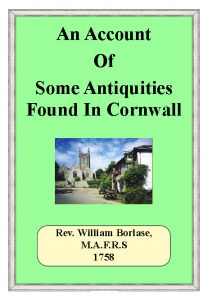AS I know the pleasure, which every branch of ancient literature gives you I should not excuse myself, if I did not communicate to you a late discovery of Roman antiquities in these westernmost parts of Britain.
In the year 1756 a farmer at Bossens, in the parish of. St. Erth, driving his oxen from the field, perceived the foot of one of them to sink a little deeper than ordinary into the earth at A, fig. 8. (See Tab. 1.) Curiosity, and the hopes of treasure, led him soon, after to search the place; where was soon discovered a perpendicular pit, circular, of two feet and half diameter. Digging to the depth of 18 feet, there was found a Roman patera (fig. 1. & 2.) : about 6 feet deeper, the jug, fig. 3: nearby, among the rubbish, the stone, fig.. 4; a small .millstone, about 18 inches diameter: then another patera, with two handles, in other particulars of the shape and size as fig. 2, but unfortunately mislaid, and not now to be found. Intermixed with these were found fragments of horns, bones of several sizes, half-burnt sticks, and many pieces of leather, seemingly shreds of worn-out shoes. Having sunk to the depth of 16 feet, they found the bottom of the pit concave, like that of a dish or bowl. There was a sensible moisture, and mostly wet clay, in all parts of the pit. On each side there were holes at due distances, capable of admitting a human foot, by which persons might descend and ascend. There is no doubt but this work must have been intended for a well: but a pit so deep, and of such narrow dimensions, must have been sunk thro’ a stony ground with much difficulty, and with tools very different from those now in use.
